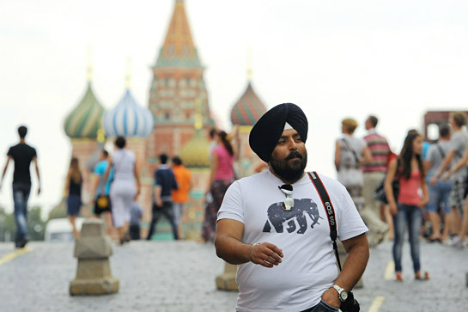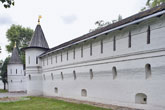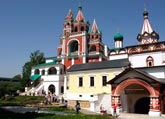Text and photographs by William Brumfield
The town of Zvenigorod, some 19 miles due west of Moscow, is one of the area’s most picturesque areas. In summer or winter, its location on high bluffs overlooking the winding Moscow River provides rare vistas of an untouched landscape. And at the center of this hilly terrain is the St. Savva-Storozhevsky Monastery.
Although the earliest written reference to Zvenigorod does not occur until 1339, it is possible that a settlement existed there as early as the reign of Yury Dolgoruky (1090s-1157), who is considered Moscow’s founding prince.
Indeed, the site provided a clear view against any approach from the west. Its name derives from the words for fortified point (gorod) and “to ring,” as in an alarm bell.
View Larger Map
During the 14th and 15th
centuries, Zvenigorod served as the center of a small principality subordinate
to the Grand Prince of Moscow. At the turn of the 15th century, the town was ruled by Prince Yury Dmitrievich
(1374-1434), son of Moscow’s renowned Prince Dmitry Donskoi.
In the late 1390s, Prince Yury gave
his support to the monk Savva to establish a monastery on a small hill known as
“Storozha,” meaning “guard,” or lookout. Savva, who died in 1407, was a
disciple of the great founder of Muscovite monasticism, St. Sergius of Radonezh.
Both monks served as spiritual advisors to Moscow’s rulers. Revered locally
after his death, Savva was canonized by the Orthodox Church in 1547.
How to get there
To get to The Savva-Storozhevsky Monastery take the local train from Moscow's Belorussky Railway Station to Zvenigorod and then take a local bus (№ 23 or № 51) and get off at the "Monastery" stop.
In 1398 work began on the
monastery’s first wooden structures, including the log Church of the Nativity
of the Virgin, to which the monastery was formally dedicated. With the devoted
support of Prince Yury, this humble structure was replaced around 1405 with a
limestone church that is one of the oldest masonry buildings to survive from
medieval Muscovy.
The Nativity Cathedral of the St.
Savva Storozhevsky Monastery is modest in size when compared with the great
Kremlin cathedrals, but its elevated single cupola, covered in gold leaf, still
serves as a dominant landmark.
The facades are decorated with an intricately
carved limestone frieze. For centuries the building stood with a simple
four-sloped roof, but a major restoration in 1972 recreated what is assumed to
have been the original appearance, with a roofline that follows the rounded
gables (zakomary.)
The west, south and north facades of
the cathedral originally had portals set within painted ogival arches, but
subsequent additions in the 17th
century enclosed all but the north portal, which is still clearly visible. On
the east is an apse of three parts, which contains the main altar.
The interior space is segmented by
four piers beneath the cylinder, or “drum,” that supports the cupola. The walls
are covered with frescoes done in 1656 by a group of artists led by the master
Stepan Ryazantsev.
During the same period, a large
chapel dedicated to St. Savva was added along the south and west facades of the
original structure. Its interior is covered with 19th-century wall paintings portraying the life of St. Savva.
Over the east part of the chapel is a small but brilliant gold cupola. The
chapel also contained the cathedral treasury.
Throughout the 15th and 16th
centuries, the monastery was favored as a spiritual retreat by Muscovy’s rulers,
who paid homage to the relics of St. Savva. In the 1550s the young Tsar Ivan IV
(the Terrible) and his beloved first wife Anastasia frequently visited the
monastery.
At the beginning of the 17the
century, the Savva-Storozhevsky Monastery suffered from the chaos of the
dynastic crisis known as the Time of Troubles. Occupied by various competing
forces, the monastery began a slow recovery following the enthronement of
Mikhail Romanov (1596-1645) and the establishment of the Romanov dynasty in
1613.
The monastery’s fortunes
dramatically improved in the 1650s with the largess of Tsar Alexei Mikhailovich
(1629-1676). By the end of the century almost every part of the monastery,
including its walls and towers, had been rebuilt in brick. Even the Nativity
Cathedral underwent substantial modifications. The frescoes in the cathedral
were also added during the expansion.
The most striking addition was the
bell tower, which contained a church dedicated to St. Sergius of Radonezh.
Erected in 1652-1654, the bell tower astonishes visitors with its panoply of
spires, bright colors and arched openings for bells.
The largest of these
bells — the 35-ton “Blagovest,” or Good Tidings — was destroyed in the fall of 1941
during an evacuation attempt as German armies advanced toward Moscow; it has
now been replaced. Attached to the bell tower on the east is the colorful
Trinity Church (1651-52), located over what had been an early east entrance to
the monastic compound.
Tsar Alexei was so captivated by the
monastery that he made it a summer residence and built extensive chambers
within the walls on the southwest side of the monastery. On the opposite side
arose chambers for his wife and her attendants.
The monastery walls and towers were
also expanded in an imposing display of royal power. Of special note is the Red
Tower over the east gate, with a small church dedicated to Aleksii, Man of God,
an ascetic who lived at the turn of the 5th
century.
After the Soviets came to power, the
monastery was closed and the relics of St. Savva were sequestered. In 1998,
after complicated negotiations, the relics were returned to the monastery,
which resumed its religious functions in 1995.
Less than a mile up the hill to the
northeast of the Savva-Sotrozhevsky monastery is a separate compound known as
the Skete (or “retreat”) of St. Savva. Here, near a sacred spring, the
venerable monk retired for prayer and meditation.
In the 1860s the site was
enclosed within its own wall, with an attached church and bell tower dedicated
to St. Savva. Slightly below the skete is a sacred spring.
In 2007, for the occasion of the 600th anniversary of the saint’s death, the shrine was
restored and the surrounding territory was embellished with floral paths. At
the same time the sacred spring was covered with a capacious wooden chapel.
Today, the St. Savva shrine has again become a pilgrimage site, nestled in the
quiet refuge of the wooded hill.
All rights reserved by Rossiyskaya Gazeta.


